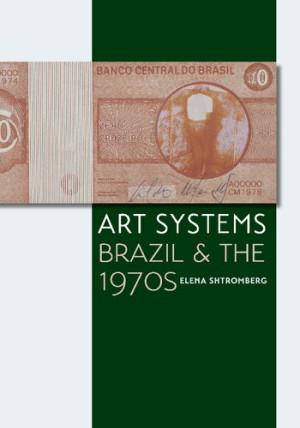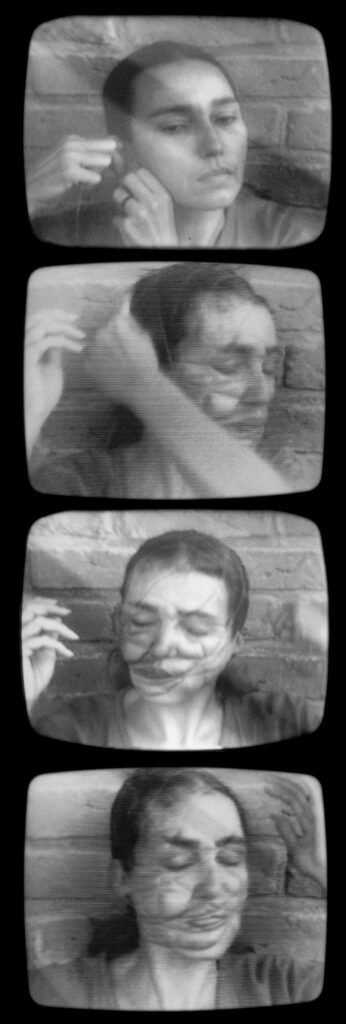Sonia Andrade
Brazilian, 1935 – 2022, Rio de Janeiro.

Sonia Andrade’s landmark early videos were shocking graphic actions featuring her own face and hands – pinched, plucked, pierced and constrained with nylon thread and wires. Body art and feminist statements via art emerged as an international sensation in the 1970s but Andrade’s imagery was distinctive – oddly quiet yet unforgettably intense. At the time of their creation, her videos were redolent of life under military dictatorship. The works remain time-bombs. They still carry the potency of all conditions of suppression, all situations inducing torture and the stunning legacy and spiritual implications of self-immolation. In another body-centric/action video, Andrade investigated the underlying numbness induced by corporatized tv and mass media, using humor and horror. In “Feijão”
(Beans, aka Untitled), 1977, she sits before a typical Brazilian meal. A tv sit-com and commercials drone on in the background. Instead of pacifying the masses, she presents an alternative impact of omnipresent advertising culture. Suddenly, almost as if possessed, she reaches into her food and smears it on her head, then over her face and inside her clothes. To add punch to her protest, she flings black beans at the camera until the lens is covered. End Scene. Even more pointed, for Untitled, 1977, the artist stands before four tvs and turns off each, whilerepeating the phrase “Turn Off the TV “… for almost ten minutes. She enlists the authority of collective Mom and the provocation of repetition to admonish the suspicious, sly power of state-regulated media.
Andrade’s art training included study at Studio Maria Tereza Vieira and classes led by Anna Bella Geiger at M.A.M (Museum of Modern Art Rio). Their contemporaries –including Fernando Cocchiarale, Arlindo Machado and Leticia Parente– produced salons, art works, theorical writings and exhibitions aimed at protesting the effete rigor of conventional aesthetics and omnipresent threat of censorship under an authoritarian regime. Artistic means ranged from drawing, assemblage, found-art, mail art, to graphics, photography, appropriation, to multimedia projections, single and multi-channel video and also, installation and performance. Artists were seeking new avenues for expression and new means to engage and reflect a public beyond art circles.
The momentum and experimental dynamic of the 70s infused Andrade’s (arguably) best known work, an installation Hydragrammas (1978-1993). Presented in various forms and venues, these were comprised of agglomerations – a myriad of over 100 small found and produced objects and their dopplegangers expressed in photographs and constructions. The artist placed these on tables to encourage viewers to peruse them and conjure inferred and imagined relationships between these points of evidence. What is invisible provided valence to the visible and vice versa – Art is a participatory Act.
Throughout her career Andrade’s work was widely exhibited in Brazil and internationally, notably at Centre Pompidou and the Louvre (Paris), the Museum of Modern Art (NYC)and Museo Nacional Centro de Arte Reina Sofia (Madrid). These, plus Harvard University (Cambridge), The Getty Institute (Los Angeles), Sammlung Verband (Vienna) and Museum fur Gestaltung (Zurich) are among the international institutions where her works have been acquired.



Video remained central in her works in the 21st century. Andrade’s ambitious installation, Get with Child a Mandrake Root, 2010,encompassed 25 video monitors to explore ancient beliefs and magical properties associated with the plant. Between 2001 and 2017, she also produced installations that incorporated video projections with crystals and rocks and light and shadow to evoke Time, Space and Reflection. The artist protested the imposition of noise, the relentless pace and the persistence of complications in contemporary life by offering a meditative, poetic alternative.
Even In her final works, Sonia Andrade remained a renegade, pushing the boundaries of Art experience.
BFVPP Essays
Marisa Flórido César 2022
How does our relationship with images take place? How does our relationship with the world mediated by images take place? How does our relationship with images mediated by technologies (like video), media (like television) and other exhibition devices (like the art system) happen?
Marcella Lista 2022
Sonia Andrade’s work is still largely unknown today. The limits of the institutional infrastructure in Brazil and the corresponding demands the artist has imposed with regard to the formulation and treatment of her work outside the art market play a telling role in this state of affairs.
Resources
Bibliography

ART SYSTEMS BRAZIL & THE 1970S
Elena Shtromberg

Elles
Volume of essays by various authors. Publisher – Getty Publications, 2023

Sonia Andrade : Arte e techologia (2010)
Exhibition Catalog : Elena Shtromberg, Maria Florido Cesar
Catalogue of the exhibition held at Oi Futuro Institute (RJ) in 2010. This is a volume on the work of installation artist Sonia Andrade.

Sonia Andrade : Video Art 1974-2005( 2005)
Centro Cultural Banco Brasil.
INTERNATIONAL INSTITUTIONAL COLLECTIONS
Sonia Andrade’s artwork is featured in the public collections of important institutions such as Centre Pompidou , Getty Research Institute , Harvard Art Museums








